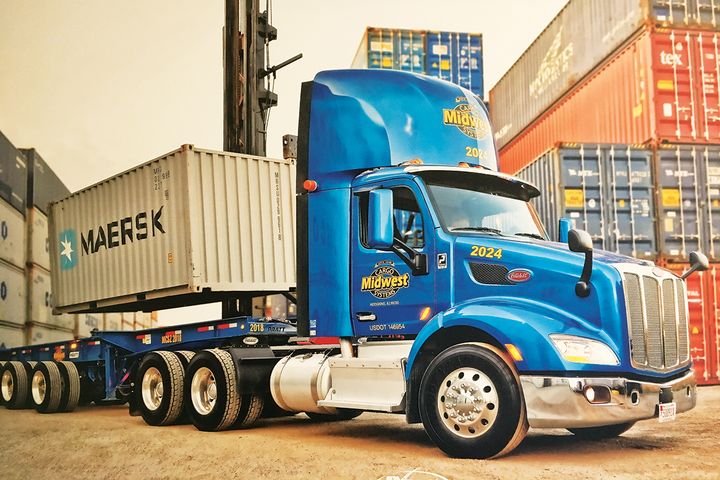Fleet Finds Ways to Say ‘Yes’ to Customer Needs
Midwest has diversified by hauling overweight as well as specialized bulk-oil intermodal containers. The fleet also offers a yard-spotting service.
Editor’s note: This is part two of a four-part series looking at how fleets are seeking to diversify their businesses and reach new customers in a time of technological and commercial disruption.
When a trucking company can trace its roots back to the owner’s grandfather delivering ice with a horse-drawn wagon, diversification is in its DNA. “That’s how it started, 80 years ago in Chicago,” says Robert Cunningham, president and owner of successor firm Midwest Cargo Systems. “Next, it was delivering heating oil. Then it was hauling LTL freight and eventually piggyback ‘rail vans,’ before containers came along.”
Today, the Hodgkins, Illinois-based company’s business is drawn from a roughly 50/50 mix of intermodal drayage and dedicated regional carriage. That mix includes a range of specialized services, such as hauling overweight as well as specialized bulk-oil intermodal containers, and a separately offered yard-spotting service.
“We do a lot of intermodal work, and our equipment is set up to be flexible,” says Brandon Denoyer, vice president. “Our 60 drayage day cab tractors carry ‘overweight’ lights for when they are needed and are spec’d with lightweight tri-axles to haul overweight containers without requiring a permit. Shippers are advised to what weight they can load the containers overseas. We feel we’re ahead of the game with this.”
Transporting the bulk oil shipped in from overseas requires hauling special containers engineered with a “bag” inside to hold the oil. Cunningham says the fleet began the bulk-oil work recently and advises that “it has challenges. The bag containers can be awkward to haul; the oil moves inside the bag. But offering this service is a natural progression for us, and our drivers are certified for this work.”
All of Midwest’s 80 drivers are company employees, which Denoyer notes is unusual when it comes to drayage. “But because they are company drivers, we have better control of the operation. We pay them a good wage, and because we have a very consistent customer base, communication with drivers is very good.”
Denoyer says the fleet’s spotting service is “not real unique, but it’s part of the total package. We can provide our seven spotter tractors and CDL drivers on site to make the customer’s life easier.”
“We’re always looking to expand into areas where we can provide our high levels of service,” he continues. “Right now, for example, we’re looking at a new piece of business that will lead to adding 35 reefer trailers to our [over-the-road] fleet of 230 vans.”
Cunningham sees the fleet’s approach as “finding niches. We see the problems our customers have, especially the new ones. Customers have needs and most of the time, we can be creative and hands-on with our solutions.”
Denoyer says Midwest aims to “recognize where we can fill a need for our existing customers. We then gather as much information as possible to tailor our services to them and see where we can be more creative and effective.”
He says that while the fleet is always looking to grow, expansion “never [comes] at the cost of jeopardizing our service level.”
“Our motto is ‘No is our last possible answer,’” Cunningham says. “If a customer has a need, no matter the difficulty, we are determined to find a way to solve their issue.” He adds that many of Midwest’s growth opportunities have come from customers saying, “We have this problem; can you help?”
by David Cullen
Source: https://www.truckinginfo.com
FLEET MANAGEMENT AUDIT
Fleet management is the use of a set of vehicles in order to provide services to a third-party, or to perform a task for our organization, in the most efficient and productive manner with a determined level of service and cost.
Fleet management activities are shown in the following graph 1:

Graph 1: fleet management activities
The proposal audit analyses and assesses all fleet management activities shown in the graph 1, and its main goals are:
- Know the overall status of the fleet management activities
- Provide the analysis, the assessment, the advice, the suggestions and the actions to take in order to cut costs and increase the efficiency and efficacy of the fleet management activities
With the information obtained, we’ll elaborate a report that holds the overall status of the fleet management as well as the suggestions, recommendations and the measures to take in order to cut costs and optimize the fleet management activities.
CLICK ON THE FOLLOWING LINK TO DOWNLOAD THE PROPOSED FLEET MANAGEMENT AUDIT:



